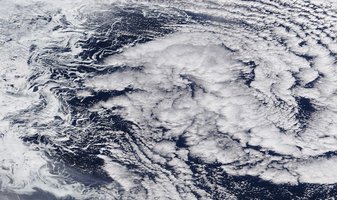Today I was astonished to see the following (Fig 1) very strange cloud formation in the WorldView imagery. Here we see filamentary cloud structures swimming through a rapidly closing sea of blue, and waves imprinted on more uniform structures to the west, with billows of stratiform layers to the east. What also struck me was the apparent symmetry (north south). We hardly ever see structures like this, and when one tries to look at this with the ground instruments nothing of the sort shows up. Hmmm.
Well for the John Oliver fans among you, this is nowhere near Barbados, rather in the North Atlantic. So apart from our Disdrometer, which continues to have its hiccups, nothing seems wrong with our instruments, except that in so far as we are interested in this particular image, they are in the wrong place. Fig 2 (ed.'s note: pic corrupted), shows the larger context, one which illustrates nicely how the clouds couple to the large scale flow, and helps contextualize our fascination with cloud forms and sub-mesoscale fronts and filaments in and over more tropical waters.
Well if I haven’t lost your attention, I wanted to add a less Oliverian note to Franziska’s post, as what I cannot understand is, if the dry air is a signature of subsidence, why it folds i to the boundary layer in bands. Or could it be that the air is subsiding strongly all the time, and in the bands the slow winds provides less competing surface moisture fluxes. It would be very interesting to compare the back trajectories between the moist and dry parts of the banded features. I’m hoping and guessing that maybe the isotopic signature will tell us how much of the dryness we can attribute to enhanced downward mixing versus lack of surface moistening, and thus might constrain the mass budget, including some of the things Markus and Heike have been looking at.
The other point I wanted to add is that I have the sense that the free-troposphere is much more stable and dry than it has been in past years. This is a hypothesis we can perhaps test as we pull in more data from the Pre EUREC4A period.

